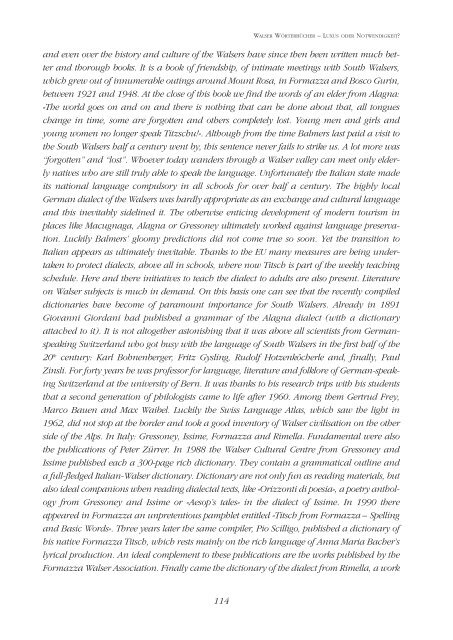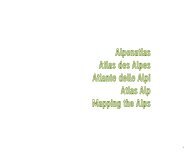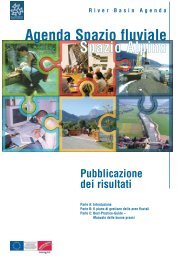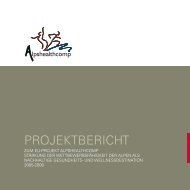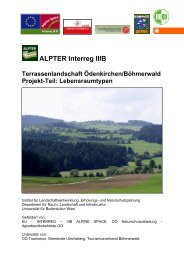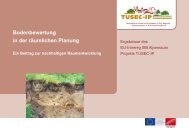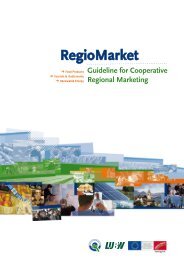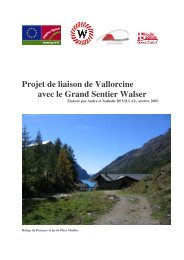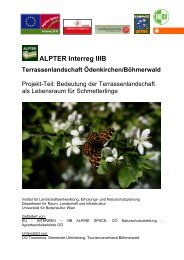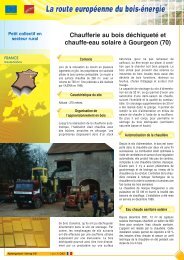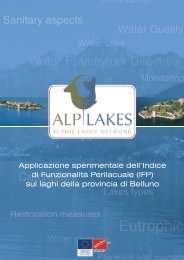WALSERSPRACHE - The four main objectives of the Alpine Space ...
WALSERSPRACHE - The four main objectives of the Alpine Space ...
WALSERSPRACHE - The four main objectives of the Alpine Space ...
Create successful ePaper yourself
Turn your PDF publications into a flip-book with our unique Google optimized e-Paper software.
WALSER WÖRTERBÜCHER – LUXUS ODER NOTWENDIGKEIT?<br />
and even over <strong>the</strong> history and culture <strong>of</strong> <strong>the</strong> Walsers have since <strong>the</strong>n been written much better<br />
and thorough books. It is a book <strong>of</strong> friendship, <strong>of</strong> intimate meetings with South Walsers,<br />
which grew out <strong>of</strong> innumerable outings around Mount Rosa, in Formazza and Bosco Gurin,<br />
between 1921 and 1948. At <strong>the</strong> close <strong>of</strong> this book we find <strong>the</strong> words <strong>of</strong> an elder from Alagna:<br />
«<strong>The</strong> world goes on and on and <strong>the</strong>re is nothing that can be done about that, all tongues<br />
change in time, some are forgotten and o<strong>the</strong>rs completely lost. Young men and girls and<br />
young women no longer speak Titzschu!». Although from <strong>the</strong> time Balmers last paid a visit to<br />
<strong>the</strong> South Walsers half a century went by, this sentence never fails to strike us. A lot more was<br />
“forgotten” and “lost”. Whoever today wanders through a Walser valley can meet only elderly<br />
natives who are still truly able to speak <strong>the</strong> language. Unfortunately <strong>the</strong> Italian state made<br />
its national language compulsory in all schools for over half a century. <strong>The</strong> highly local<br />
German dialect <strong>of</strong> <strong>the</strong> Walsers was hardly appropriate as an exchange and cultural language<br />
and this inevitably sidelined it. <strong>The</strong> o<strong>the</strong>rwise enticing development <strong>of</strong> modern tourism in<br />
places like Macugnaga, Alagna or Gressoney ultimately worked against language preservation.<br />
Luckily Balmers’ gloomy predictions did not come true so soon. Yet <strong>the</strong> transition to<br />
Italian appears as ultimately inevitable. Thanks to <strong>the</strong> EU many measures are being undertaken<br />
to protect dialects, above all in schools, where now Titsch is part <strong>of</strong> <strong>the</strong> weekly teaching<br />
schedule. Here and <strong>the</strong>re initiatives to teach <strong>the</strong> dialect to adults are also present. Literature<br />
on Walser subjects is much in demand. On this basis one can see that <strong>the</strong> recently compiled<br />
dictionaries have become <strong>of</strong> paramount importance for South Walsers. Already in 1891<br />
Giovanni Giordani had published a grammar <strong>of</strong> <strong>the</strong> Alagna dialect (with a dictionary<br />
attached to it). It is not altoge<strong>the</strong>r astonishing that it was above all scientists from Germanspeaking<br />
Switzerland who got busy with <strong>the</strong> language <strong>of</strong> South Walsers in <strong>the</strong> first half <strong>of</strong> <strong>the</strong><br />
20 th century: Karl Bohnenberger, Fritz Gysling, Rudolf Hotzenköcherle and, finally, Paul<br />
Zinsli. For forty years he was pr<strong>of</strong>essor for language, literature and folklore <strong>of</strong> German-speaking<br />
Switzerland at <strong>the</strong> university <strong>of</strong> Bern. It was thanks to his research trips with his students<br />
that a second generation <strong>of</strong> philologists came to life after 1960. Among <strong>the</strong>m Gertrud Frey,<br />
Marco Bauen and Max Waibel. Luckily <strong>the</strong> Swiss Language Atlas, which saw <strong>the</strong> light in<br />
1962, did not stop at <strong>the</strong> border and took a good inventory <strong>of</strong> Walser civilisation on <strong>the</strong> o<strong>the</strong>r<br />
side <strong>of</strong> <strong>the</strong> Alps. In Italy: Gressoney, Issime, Formazza and Rimella. Fundamental were also<br />
<strong>the</strong> publications <strong>of</strong> Peter Zürrer. In 1988 <strong>the</strong> Walser Cultural Centre from Gressoney and<br />
Issime published each a 300-page rich dictionary. <strong>The</strong>y contain a grammatical outline and<br />
a full-fledged Italian-Walser dictionary. Dictionary are not only fun as reading materials, but<br />
also ideal companions when reading dialectal texts, like «Orizzonti di poesia», a poetry anthology<br />
from Gressoney and Issime or «Aesop’s tales» in <strong>the</strong> dialect <strong>of</strong> Issime. In 1990 <strong>the</strong>re<br />
appeared in Formazza an unpretentious pamphlet entitled «Titsch from Formazza – Spelling<br />
and Basic Words». Three years later <strong>the</strong> same compiler, Pio Scilligo, published a dictionary <strong>of</strong><br />
his native Formazza Titsch, which rests <strong>main</strong>ly on <strong>the</strong> rich language <strong>of</strong> Anna Maria Bacher’s<br />
lyrical production. An ideal complement to <strong>the</strong>se publications are <strong>the</strong> works published by <strong>the</strong><br />
Formazza Walser Association. Finally came <strong>the</strong> dictionary <strong>of</strong> <strong>the</strong> dialect from Rimella, a work<br />
114


